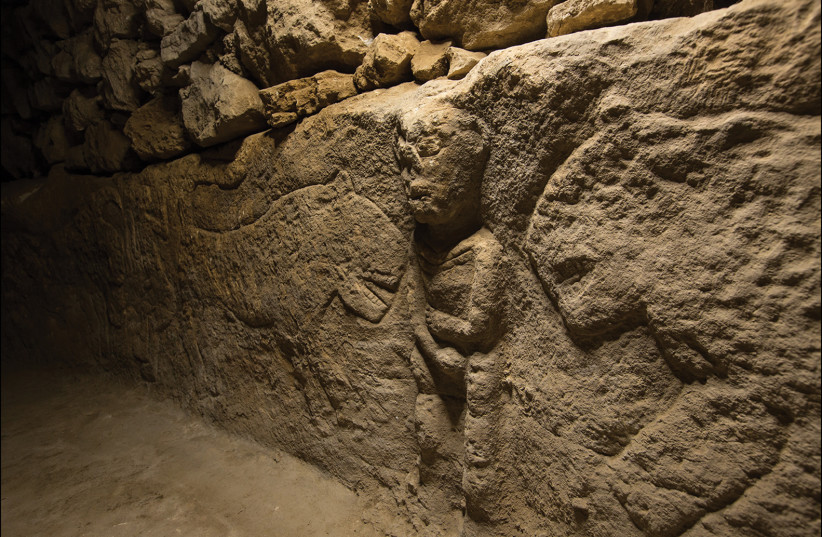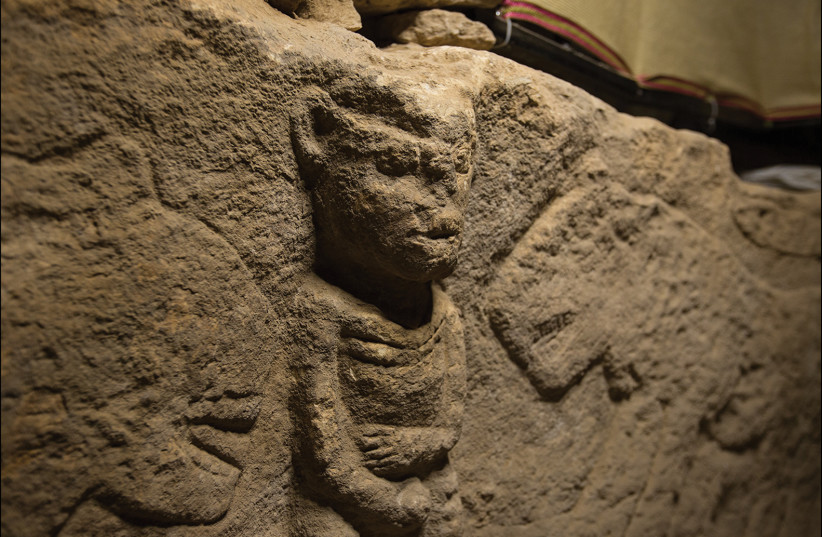 Archaeologists find world’s oldest narrative story, and it’s intense
Archaeologists find world’s oldest narrative story, and it’s intense
AARON REICH
The carvings depict a man holding his penis flanked by leopards, and another man holding a snake standing next to a bull.
.

(photo credit: K. Akdemir)
Archaeologists have managed to uncover what is believed to be the oldest narrative depiction in history: A man holding his penis while being flanked by leopards, and another man sitting near a bull and holding a snake, according to a new study.
Discovered in southeastern Turkey, the carving is important because not only does it depict a narrative, meaning a story, but the carving itself is dated to the ninth millennium BCE – over 11,000 years ago.
The findings of this study were published by Istanbul University archaeologist Eylem Özdoğan in the peer-reviewed academic journal Antiquity.
What is the world’s oldest drawn story?
Many people have widely cited the famous Epic of Gilgamesh as the world’s oldest story.
This is not exactly true, however. While it is the oldest epic poem and it is one of the most influential pieces of writing in history, it was only from the 18th century BCE.

Stories, however, have been a part of human culture for far longer.
Rather, they seem to have been formed alongside the development of primitive human societies, with evidence of it first cropping up in the Neolithic era.
This particular era was defined by a number of things, most notably humans abandoning the hunter-gatherer lifestyle for a more sedentary agricultural life.
Here, evidence starts to crop up due to prolonged human settlement, which allows researchers to see how social roles developed, and so on. This also can see some links to symbols and rituals, which are inherently linked to stories.
In other words, seeing early stories can tell about the society that made them.
This story in particular is told in the form of carvings in Sayburç, Turkey near the Syrian border.
These carvings depict five figures in two scenes. The first scene depicts a human holding his penis in his right hand, with round protrusions on the knees implying he is bent forward while sitting. Standing on both sides of him are two leopards, each with open mouths with teeth and curled tails, with one leopard having a visible penis.
The second scene depicts another human, this one with his penis on his abdomen and squatting down. In his hand is what appears to be either a snake or a rattle, head pointing to the ground. Standing next to the man is a bull, with both horns visible.
Notably, the second scene has the human with his back turned to the three figures in the first scene.
So what does it mean?
Well, there are a few things we can tell right off the bat, especially when comparing it to other Neolithic carvings.
First, the use of the penis seems to mainly be a form of showing gender. Secondly, we can see that the dangerous aspects of animals, such as leopard teeth and bull horns, are shown emphasized.
Both of these are common in other Neolithic carvings.
What is different, however, is that the two carvings form a narrative, a story in their own right.
As for the meaning of the story, we may not know specifics, but it seems to be a comment on the relationship between humans and animals.
Later Neolithic art would show humans and animals stacked on top of each other, such as humans carrying animals.
But these carvings have humans and animals on the same horizontal level.
But what does that mean? That’s the part we aren’t sure about. Most likely, however, the progressing narrative story in these two scenes seems to indicate that this is meant to indicate specific events or stories are being told.
What those stories are, however, isn’t clear.
Speaking to science news outlet LiveScience, Neolithic archaeologist Jens Notroff, who was not involved in the study, explained that most likely, there are references here that modern humans won’t recognize.
“Unfortunately, while the Neolithic hunter may have easily recognized its message,” he told LiveScience, “we are still lacking an understanding of the actual narrative.”
However, that doesn’t mean it will stay a mystery forever.
The area in Sayburç is still being excavated, and there is more work to be done. There may be more carvings to find nearby. Perhaps the missing pieces are still waiting to be found.
Zawartość publikowanych artykułów i materiałów nie reprezentuje poglądów ani opinii Reunion’68,
ani też webmastera Blogu Reunion’68, chyba ze jest to wyraźnie zaznaczone.
Twoje uwagi, linki, własne artykuły lub wiadomości prześlij na adres:
webmaster@reunion68.com
